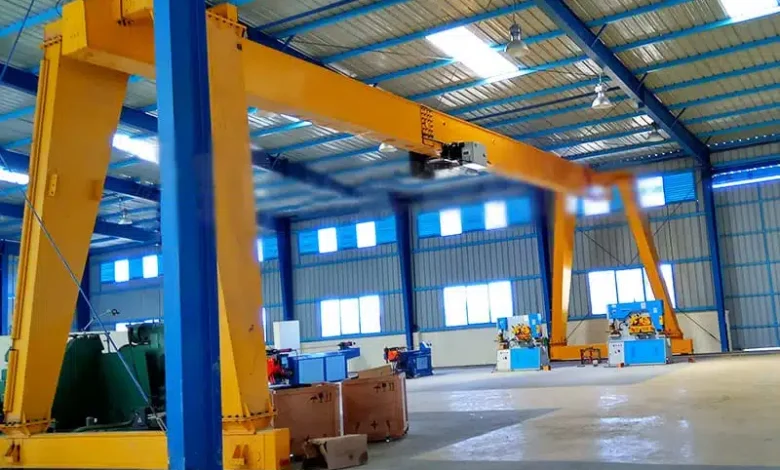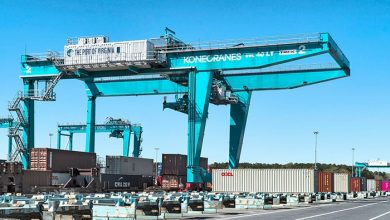
Table of Contents
ToggleIn industrial settings, heavy lifting and transporting materials safely and efficiently is a crucial part of day-to-day operations. One of the key machines that make this possible is the gantry crane. Gantry cranes have become a staple in various sectors due to their versatility, ease of operation, and ability to handle heavy loads. In this article, we will explore what gantry cranes are, the different types available, and their diverse applications across industries.
What is a Gantry Crane?
A gantry crane is a type of crane that uses a structure, or “gantry,” made of a framework of beams, columns, and rails to support the lifting mechanism. The crane moves along the rails on the gantry, which is usually supported by legs or wheels. This design allows the crane to lift and move heavy loads across a defined area, typically large open spaces such as warehouses, factories, ports, or construction sites.
Unlike traditional overhead cranes, which are fixed to a building or structure, gantry cranes are typically portable. They can be moved from one location to another, making them an excellent option for applications that require flexibility. Their versatility and ease of setup have made gantry cranes a preferred choice in various industries.
The Structure of a Gantry Crane
The basic components of a gantry crane include:
-
Gantry Frame: This is the supporting structure, usually made of steel or heavy-duty aluminum. It includes the two vertical legs and the crossbeam that connects them.
-
Lifting Mechanism: This consists of the hoist or trolley that carries the load. The hoist is mounted on the crossbeam and can move horizontally along it.
-
Runways or Rails: These are the tracks along which the crane moves. They are typically positioned at the base of the gantry legs and allow the crane to travel across the work area.
-
Control Systems: These include the power and electrical systems needed to control the hoist’s movement, along with safety features like limit switches, emergency stop buttons, and sensors.
Types of Gantry Cranes
There are several types of gantry cranes, each designed for specific applications. Here are some of the most common types:
1. Single Girder Gantry Crane
A single girder gantry crane uses one horizontal beam (the girder) to support the lifting mechanism. This is the simplest and most cost-effective type of gantry crane. Single girder gantries are ideal for lighter loads and smaller spaces where the lifting capacity requirements are not as high. They are widely used in smaller warehouses, garages, or construction sites.
2. Double Girder Gantry Crane
A double girder gantry crane features two horizontal beams, providing greater lifting capacity and stability compared to the single girder model. This type of gantry crane is typically used in large-scale operations such as ports, shipyards, or heavy manufacturing industries. Double girder gantries are designed to handle heavier loads and offer more flexibility when lifting and moving items.
3. Portable Gantry Crane
As the name suggests, portable gantry cranes are designed to be lightweight and easily moved from one location to another. They are typically used in smaller industrial settings where heavy lifting is needed, but a permanent installation isn’t feasible. Portable gantry cranes are ideal for use in construction sites, workshops, and warehouses that require occasional heavy lifting.
4. Underhung Gantry Crane
An underhung gantry crane has its trolley system running beneath the gantry’s structure. This type is often used in facilities where space is limited or where an overhead lifting system is already in place. Underhung gantries are useful in smaller areas where overhead cranes cannot be installed due to structural limitations.
5. Semi-Gantry Crane
A semi-gantry crane is a hybrid of a regular gantry crane and an overhead crane. It features a structure similar to that of a gantry crane, but only one of the legs runs on rails, while the other leg is fixed to a building or structure. This design makes semi-gantry cranes ideal for operations where a fixed structure is available but additional overhead clearance is needed for the lifting task.
Applications of Gantry Cranes
Gantry cranes have a wide range of applications across different industries. Here are some key areas where gantry cranes are commonly used:
1. Port and Shipping Industry
The shipping industry is one of the largest users of gantry cranes. These cranes are essential in moving heavy containers from ships to the dock and vice versa. They are used in container terminals, where containers need to be loaded, unloaded, and transported across the yard. Gantry cranes in ports are typically large, double girder designs that can lift and move containers weighing several tons.
2. Construction Sites
Gantry cranes are invaluable in construction projects, particularly in the lifting and movement of heavy materials, such as steel beams, concrete slabs, and machinery. Since construction sites often involve limited space and frequent changes in layout, gantry cranes provide the flexibility needed to move heavy items across various parts of the site. Portable gantry cranes are commonly used here for smaller, localized lifting tasks.
3. Manufacturing and Warehousing
In factories and warehouses, gantry cranes are used for moving raw materials, finished goods, or components within the facility. They are used for tasks such as lifting machinery, moving large parts during assembly, or organizing goods within the warehouse. The ability to move goods from one part of the facility to another ensures smooth and efficient operations.
4. Heavy Equipment and Machinery Handling
Industries that deal with large, heavy equipment, such as aerospace or shipbuilding, rely on gantry cranes to transport and position massive parts and machinery. These cranes are essential for assembling large machines, positioning turbine parts, or moving heavy engines in an aerospace manufacturing facility.
5. Renewable Energy Projects
In renewable energy, particularly in wind turbine installation, gantry cranes are used to lift and place large turbine components, such as blades, nacelles, and towers. These cranes are also used in the maintenance of wind farms, ensuring that equipment can be easily moved to and from remote locations.
Conclusion
Gantry cranes are integral tools in industries requiring the movement of heavy loads across large spaces. Their flexibility, ease of use, and ability to handle significant weight make them an essential part of various operations, from manufacturing to shipping and construction. By understanding the different types of gantry cranes and their diverse applications, industries can make more informed decisions about which type of crane suits their specific needs. Whether you’re looking to invest in a gantry crane for your business or simply want to learn more about how they function, knowing the basics can help optimize operations and improve safety and efficiency in the workplace.




